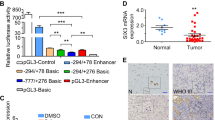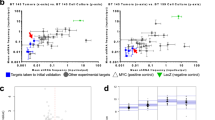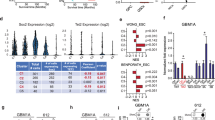Abstract
Tumor stem cells, postulated to be the source cells for malignancies, have been identified in several cancers using cell-surface expression of markers including CD133, a pentaspan membrane protein. CD133+ve cells form neurospheres, exhibit self-renewal and differentiation, and are tumorigenic. However, despite its association with stem cells, a causal relationship of CD133 to tumorigenesis remains to be defined. Hypothesizing that specific epigenetic and transcription factors implicated in driving the stem cell state may concurrently regulate CD133 expression in stem cells, we analyzed the structure and regulation of CD133 promoter in glioma stem cells and glioma cell lines. Initially, a minimal promoter region was identified by analyzing the activity of CD133 promoter-driven luciferase-expressing 5'-and 3'-deletion-constructs upstream of the transcription start site. This region contained a CpG island that was hypermethylated in CD133−ve glioma stem cells (GSC) and glioma cells but unmethylated in CD133+ve ones. Of several predicted TF-binding sites in this region, the role of tandem Sp1 (−242 and −221) and two Myc (−541 and −25)-binding sites were examined. Overexpression of Sp1 or Myc increased CD133 minimal promoter-driven luciferase activity and CD133 levels in GSC and in glioma cell line. Mithramycin, a Sp1 inhibitor, decreased minimal promoter activity and downregulated CD133 levels in GSC. Gel-shift assays demonstrated direct binding of Sp1 to their predicted sites that was competitively inhibited by oligonucleotide-binding-site sequences and supershifted by anti-Sp1 confirming the interaction. Sp1 and Myc-antibody chromatin immunoprecipitation (ChIP) analysis in GSC showed enrichment of regions with Sp1 and Myc-binding sites. In CD133−ve cells, ChIP analysis showed binding of the methyl-DNA-binding proteins, MBD1, MBD2 and MeCP2 to the methylated CpG island and repression of transcription. These results demonstrate that Sp1 and Myc regulate CD133 transcription in GSC and that promoter methylation and methyl-DNA-binding proteins cause repression of CD133 by excluding transcription-factor binding.
This is a preview of subscription content, access via your institution
Access options
Subscribe to this journal
Receive 50 print issues and online access
$259.00 per year
only $5.18 per issue
Buy this article
- Purchase on Springer Link
- Instant access to full article PDF
Prices may be subject to local taxes which are calculated during checkout







Similar content being viewed by others
Accession codes
References
Reya T, Morrison SJ, Clarke MF, Weissman IL . Stem cells, cancer, and cancer stem cells. Nature [Review] 2001; 414: 105–111.
Yin AH, Miraglia S, Zanjani ED, Almeida-Porada G, Ogawa M, Leary AG et al. AC133, a novel marker for human hematopoietic stem and progenitor cells. Blood 1997; 90: 5002–5012.
Corbeil D, Roper K, Hellwig A, Tavian M, Miraglia S, Watt SM et al. The human AC133 hematopoietic stem cell antigen is also expressed in epithelial cells and targeted to plasma membrane protrusions. J Biol Chem 2000; 275: 5512–5520.
Miraglia S, Godfrey W, Yin AH, Atkins K, Warnke R, Holden JT et al. A novel five-transmembrane hematopoietic stem cell antigen: isolation, characterization, and molecular cloning. Blood 1997; 90: 5013–5021.
Uchida N, Buck DW, He D, Reitsma MJ, Masek M, Phan TV et al. Direct isolation of human central nervous system stem cells. Proc Natl Acad Sci USA 2000; 97: 14720–14725.
Weigmann A, Corbeil D, Hellwig A, Huttner WB . Prominin, a novel microvilli-specific polytopic membrane protein of the apical surface of epithelial cells, is targeted to plasmalemmal protrusions of non-epithelial cells. Proc Natl Acad Sci USA. 1997; 94: 12425–12430.
Shmelkov SV, St Clair R, Lyden D, Rafii S . AC133/CD133/Prominin-1. Int J Biochem Cell Biol 2005; 37: 715–719.
Neuzil J, Stantic M, Zobalova R, Chladova J, Wang X, Prochazka L et al. Tumour-initiating cells vs cancer 'stem' cells and CD133: what's in the name? Biochem Biophys Res Commun 2007; 355: 855–859.
Singh SK, Hawkins C, Clarke ID, Squire JA, Bayani J, Hide T et al. Identification of human brain tumour initiating cells. Nature 2004; 432: 396–401.
Beier D, Hau P, Proescholdt M, Lohmeier A, Wischhusen J, Oefner PJ et al. CD133(+) and CD133(-) glioblastoma-derived cancer stem cells show differential growth characteristics and molecular profiles. Cancer Res 2007; 67: 4010–4015.
Chen R, Nishimura MC, Bumbaca SM, Kharbanda S, Forrest WF, Kasman IM et al. A hierarchy of self-renewing tumor-initiating cell types in glioblastoma. Cancer Cell 2010; 17: 362–375.
Zeppernick F, Ahmadi R, Campos B, Dictus C, Helmke BM, Becker N et al. Stem cell marker CD133 affects clinical outcome in glioma patients. Clin Cancer Res 2008; 14: 123–129.
Liu G, Yuan X, Zeng Z, Tunici P, Ng H, Abdulkadir IR et al. Analysis of gene expression and chemoresistance of CD133+ cancer stem cells in glioblastoma. Mol Cancer 2006; 5: 67.
Bao S, Wu Q, McLendon RE, Hao Y, Shi Q, Hjelmeland AB et al. Glioma stem cells promote radioresistance by preferential activation of the DNA damage response. Nature 2006; 444: 756–760.
Tabu K, Sasai K, Kimura T, Wang L, Aoyanagi E, Kohsaka S et al. Promoter hypomethylation regulates CD133 expression in human gliomas. Cell Res 2008; 18: 1037–1046.
Yi JM, Tsai HC, Glockner SC, Lin S, Ohm JE, Easwaran H et al. Abnormal DNA methylation of CD133 in colorectal and glioblastoma tumors. Cancer Res 2008; 68: 8094–8103.
Shmelkov SV, Jun L, St Clair R, McGarrigle D, Derderian CA, Usenko JK et al. Alternative promoters regulate transcription of the gene that encodes stem cell surface protein AC133. Blood 2004; 103: 2055–2061.
Marsden CG, Wright MJ, Pochampally R, Rowan BG . Breast tumor-initiating cells isolated from patient core biopsies for study of hormone action. Methods Mol Biol 2009; 590: 363–375.
Al-Hajj M, Wicha MS, Benito-Hernandez A, Morrison SJ, Clarke MF . Prospective identification of tumorigenic breast cancer cells. Proc Natl Acad Sci USA 2003; 100: 3983–3988.
Ricci-Vitiani L, Lombardi DG, Pilozzi E, Biffoni M, Todaro M, Peschle C et al. Identification and expansion of human colon-cancer-initiating cells. Nature 2007; 445: 111–115.
Kemper K, Sprick MR, de Bree M, Scopelliti A, Vermeulen L, Hoek M et al. The AC133 epitope, but not the CD133 protein, is lost upon cancer stem cell differentiation. Cancer Research 2010; 70: 719–729.
Elsaba TM, Martinez-Pomares L, Robins AR, Crook S, Seth R, Jackson D et al. The stem cell marker CD133 associates with enhanced colony formation and cell motility in colorectal cancer. PLoS One 2010; 5: 10714.
Briggs MR, Kadonaga JT, Bell SP, Tjian R . Purification and biochemical characterization of the promoter-specific transcription factor, Sp1. Science 1986; 234: 47–52.
Kadonaga JT, Courey AJ, Ladika J, Tjian R . Distinct regions of Sp1 modulate DNA binding and transcriptional activation. Science 1988; 242: 1566–1570.
Kadonaga JT, Carner KR, Masiarz FR, Tjian R . Isolation of cDNA encoding transcription factor Sp1 and functional analysis of the DNA binding domain. Cell 1987; 51: 1079–1090.
Cheng L, Jin Z, Liu L, Yan Y, Li T, Zhu X et al. Characterization and promoter analysis of the mouse nestin gene. FEBS Lett 2004; 565: 195–202.
Wu DY, Yao Z . Functional analysis of two Sp1/Sp3 binding sites in murine Nanog gene promoter. Cell Res 2006; 16: 319–322.
Ray BK, Ray A . Sp1-mediated transactivation of the rabbit alpha 1 acid glycoprotein-encoding gene involves a cis-acting element in the 5'-proximal promoter region. Gene 1994; 147: 253–258.
Lopez-Rodriguez C, Chen HM, Tenen DG, Corbi AL . Identification of Sp1-binding sites in the CD11c (p150,95 alpha) and CD11a (LFA-1 alpha) integrin subunit promoters and their involvement in the tissue-specific expression of CD11c. Eur J Immunol 1995; 25: 3496–3503.
Chen HM, Pahl HL, Scheibe RJ, Zhang DE, Tenen DG . The Sp1 transcription factor binds the CD11b promoter specifically in myeloid cells in vivo and is essential for myeloid-specific promoter activity. J Biol Chem 1993; 268: 8230–8239.
Adhikary S, Eilers M . Transcriptional regulation and transformation by Myc proteins. Nat Rev Mol Cell Biol 2005; 6: 635–645.
Cowling VH, Cole MD . Mechanism of transcriptional activation by the Myc oncoproteins. Semin Cancer Biol 2006; 16: 242–252.
Parisi F, Wirapati P, Naef F . Identifying synergistic regulation involving c-Myc and sp1 in human tissues. Nucleic Acids Res 2007; 35: 1098–1107.
Wang J, Wang H, Li Z, Wu Q, Lathia JD, McLendon RE et al. c-Myc is required for maintenance of glioma cancer stem cells. PLoS One 2008; 3: 3769.
Zheng H, Ying H, Yan H, Kimmelman AC, Hiller DJ, Chen AJ et al. p53 and Pten control neural and glioma stem/progenitor cell renewal and differentiation. Nature 2008; 455: 1129–1133.
Bednarik DP, Duckett C, Kim SU, Perez VL, Griffis K, Guenthner PC et al. DNA CpG methylation inhibits binding of NF-kappa B proteins to the HIV-1 long terminal repeat cognate DNA motifs. New Biol 1991; 3: 969–976.
Comb M, Goodman HM . CpG methylation inhibits proenkephalin gene expression and binding of the transcription factor AP-2. Nucleic Acids Res 1990; 18: 3975–3982.
Mancini DN, Singh SM, Archer TK, Rodenhiser DI . Site-specific DNA methylation in the neurofibromatosis (NF1) promoter interferes with binding of CREB and SP1 transcription factors. Oncogene 1999; 18: 4108–4119.
Mancini DN, Rodenhiser DI, Ainsworth PJ, O'Malley FP, Singh SM, Xing W et al. CpG methylation within the 5' regulatory region of the BRCA1 gene is tumor specific and includes a putative CREB binding site. Oncogene 1998; 16: 1161–1169.
Ohtani-Fujita N, Fujita T, Aoike A, Osifchin NE, Robbins PD, Sakai T . CpG methylation inactivates the promoter activity of the human retinoblastoma tumor-suppressor gene. Oncogene 1993; 8: 1063–1067.
Zutter MM, Ryan EE, Painter AD . Binding of phosphorylated Sp1 protein to tandem Sp1 binding sites regulates alpha2 integrin gene core promoter activity. Blood 1997; 90: 678–689.
Dynan WS, Tjian R . The promoter-specific transcription factor Sp1 binds to upstream sequences in the SV40 early promoter. Cell 1983; 35: 79–87.
Kyo S, Takakura M, Taira T, Kanaya T, Itoh H, Yutsudo M et al. Sp1 cooperates with c-Myc to activate transcription of the human telomerase reverse transcriptase gene (hTERT). Nucleic Acids Res 2000; 28: 669–677.
Lewis JD, Meehan RR, Henzel WJ, Maurer-Fogy I, Jeppesen P, Klein F et al. Purification, sequence, and cellular localization of a novel chromosomal protein that binds to methylated DNA. Cell 1992; 69: 905–914.
Boyes J, Bird A . Repression of genes by DNA methylation depends on CpG density and promoter strength: evidence for involvement of a methyl-CpG binding protein. EMBO J 1992; 11: 327–333.
Boyes J, Bird A . DNA methylation inhibits transcription indirectly via a methyl-CpG binding protein. Cell 1991; 64: 1123–1134.
Clouaire T, de Las Heras JI, Merusi C, Stancheva I . Recruitment of MBD1 to target genes requires sequence-specific interaction of the MBD domain with methylated DNA. Nucleic Acids Res 2010; 38: 4620–4634.
Ng HH, Jeppesen P, Bird A . Active repression of methylated genes by the chromosomal protein MBD1. Mol Cell Biol 2000; 20: 1394–1406.
Hendrich B, Bird A . Identification and characterization of a family of mammalian methyl-CpG binding proteins. Mol Cell Biol 1998; 18: 6538–6547.
Jiang H, Gomez-Manzano C, Aoki H, Alonso MM, Kondo S, McCormick F et al. Examination of the therapeutic potential of Delta-24-RGD in brain tumor stem cells: role of autophagic cell death. J Natl Cancer Inst. 2007; 99: 1410–1414.
Acknowledgements
We acknowledge the Gregory Jungeblut Brain Tumor Research Fund, The Dr Marnie Rose Foundation and the Chuoke Brain Tumor Fund for providing funding support for this project.
Author information
Authors and Affiliations
Corresponding author
Ethics declarations
Competing interests
The authors declare no conflict of interest
Additional information
Supplementary Information accompanies the paper on the Oncogene website
Supplementary information
Rights and permissions
About this article
Cite this article
Gopisetty, G., Xu, J., Sampath, D. et al. Epigenetic regulation of CD133/PROM1 expression in glioma stem cells by Sp1/myc and promoter methylation. Oncogene 32, 3119–3129 (2013). https://doi.org/10.1038/onc.2012.331
Received:
Revised:
Accepted:
Published:
Issue Date:
DOI: https://doi.org/10.1038/onc.2012.331
Keywords
This article is cited by
-
Emerging roles of prominin-1 (CD133) in the dynamics of plasma membrane architecture and cell signaling pathways in health and disease
Cellular & Molecular Biology Letters (2024)
-
The addition of arginine deiminase potentiates Mithramycin A-induced cell death in patient-derived glioblastoma cells via ATF4 and cytochrome C
Cancer Cell International (2023)
-
mRNA modification orchestrates cancer stem cell fate decisions
Molecular Cancer (2020)
-
Epigenetic dynamics in cancer stem cell dormancy
Cancer and Metastasis Reviews (2020)
-
Stem cell fate in cancer growth, progression and therapy resistance
Nature Reviews Cancer (2018)



